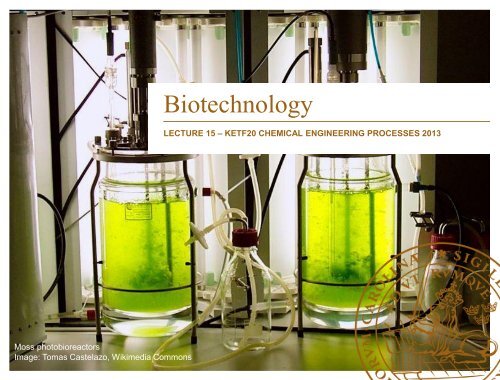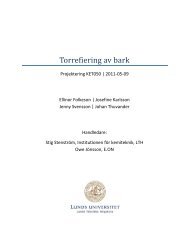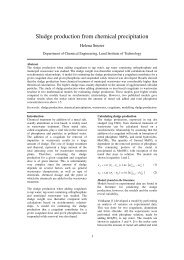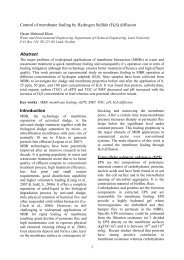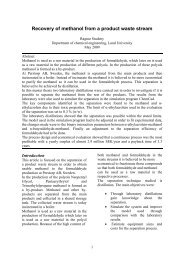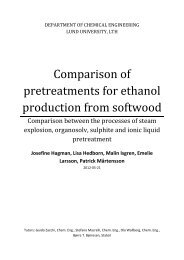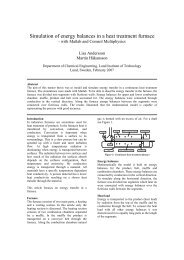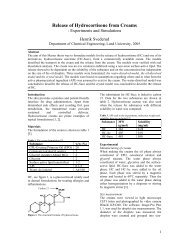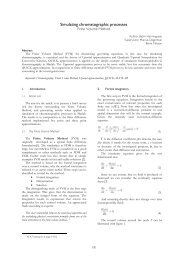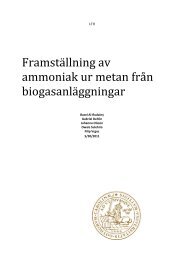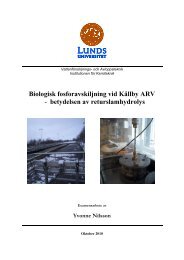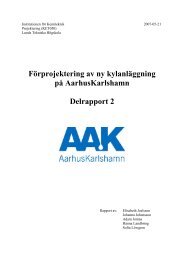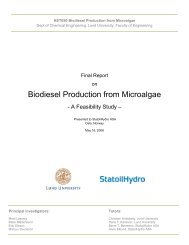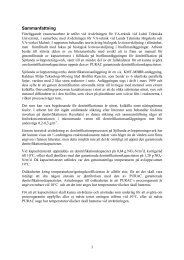Biotechnology - Department of Chemical Engineering
Biotechnology - Department of Chemical Engineering
Biotechnology - Department of Chemical Engineering
Create successful ePaper yourself
Turn your PDF publications into a flip-book with our unique Google optimized e-Paper software.
<strong>Biotechnology</strong>LECTURE 15 – KETF20 CHEMICAL ENGINEERING PROCESSES 2013Moss photobioreactorsImage: Tomas Castelazo, Wikimedia Commons
2Outline• Market outlook• History <strong>of</strong> biotechnology• <strong>Biotechnology</strong>– Organisms– Reactors– Process design• Examples <strong>of</strong> industrial biotechnology
Market outlook3
4Market outlookMarket cap <strong>of</strong> biotech productsCitric acid1.5 bio US$LysineGlutamatePenicillinsCephalosporins500 mio US$1 bio US$4 bio US$10 bio US$O NH ONH 3CSCH 3OHOhGH1 bio US$Interferons2 bio US$
Approximate price ($/kg)5Market outlook10 910 810 7NeupogenErythropoietin-Interferon10 6Streptokinase10 5Insulin10 410 310 210 110 010 -1LovastatinCephalosporins (ferm.)L-ValineL-PhenylanilineErythromycinesL-LysineCitric acidPenicillin G(natural)Benzene 3)10 1.00E+001.00E+011.00E+021.00E+031.00E+041.00E+051.00E+061.00E+071.00E+081.00E+091.00E+101.00E+111.00E+121.00E+130 10 1 10 2 10 3 10 4 10 5 10 6 10 7 10 8 10 9 10 10 10 11 10 12 10 13Approximate world production (kg/a)L-Glutamic acidEthanol (ferm.)Ethene 3)Crude oilPropene 3)Production and cost <strong>of</strong> biotechnoloy products compared to some important bulk chemicals
6Market outlookProduct costs from a different angle
7Biotechnical processesFeedstockEnzymes, cellsProductA carbon source (sugar)Nitrogen source (ammonium)Additional nutrients
8Biotechnical processes• Fermentation processes• Enzyme processes• Bio-transformations
9Fermentation processes• Food industry– Changes in foodstuff qualities– Protein production (SCP)• Synthesis <strong>of</strong> chemicals– Bulk chemicals (Ethanol, organic acids, monomers)– Fine chemicals (antibiotics, optically pure chemicals)• Production <strong>of</strong> therapeutic proteins– insulin, growth hormone, tPA, vaccines etc.• Water/soil purification– Heavy metals, phenols, oils etc.
10Schematics <strong>of</strong> metabolismMetabolic byproductsTransportSubstratesTransportSubstratesFueling reactionsPrecursormetabolitesBiosyntheticreactionsBuildingblocksPolymerizationreactionsMacromoleculesSecretionAssemblyreactionsProteinsBiomass(more cells)
Conversion processes• Cells need for reproduction and growth– carbon» polysaccharides, hydrocarbons, alcohols, carbon dioxide,molasses, pharmaceutical media, etc.– nitrogen» ammonia, urea, amino acids, ..– minerals» phosphates, sulfates, chlorides, ..– trace elements» K, Na, Mg, Ca, Fe, Co, Zn, ..– vitamins (frequently)– oxygen (aerobic processes)11
12ON H OthersC
13<strong>Biotechnology</strong> characteristics• Low temperature – low rate <strong>of</strong> reaction• High selectivity – also stereoselectivity• Multi phase processes– Gas-liquid– Gas-liquid-solid• Sterile environments required• Specific legal requirements– Pharmaceuticals– GMO
A brief history <strong>of</strong> biotechnologyDistillery in the end <strong>of</strong> the 19 th centuryImage: Novo information brochure14
15A brief history <strong>of</strong> biotechnology• Beerbrewing and baking (thousand <strong>of</strong> years old)• Microbial cultures (end <strong>of</strong> 19th century)– Pasteur• Fed-batch (~1920)– Yeast production• Fermentation technology (~1940)– Penicillin production• Genetic engineering (~1970)– Cohen and Boyer 1972
16A brief history <strong>of</strong> biotechnology• Metabolic engineering (~1990)• Functional genomics– the HUGO project• ”-omics”• Systems biology – the current trend
17A brief history <strong>of</strong> biotechnologyA modern biotechnological process unit.
18Biotechnological product categories• Bulk chemicals– Large quantities (bio-ethanol)• Fine chemicals– High value – low volume– Metabolites, biotransformation products• Proteins– Therapeutic proteins– Enzymes (non pharmaceutical)• Biomass– Food and feed
19Organisms• Organisms in industrial production include– Bacteria» Escherichia coli, Bacillus subtilis– Yeast» Saccharomyces cerevisiae– Fungi» Aspergillus niger, Aspergillus oryzae, Trichodermareesei– Cells from insects and plants
20OrganismsOrganism Pros ConsBacteria Fast growth ProcaryotesLow cost substratesLimited biosynthesisYeast Eucaryotes Limited excretionFilamentous fungiAdvancedbiosynthesisGood proteinexcretionComplex morphologyHigh viscosity media
Product Organism UseIndustrial enzymesLipasesProteasesCellulasesPectinasesBeer, wineFilamentous fungi e.g.Aspergillus spp.Trichoderma spp.Bacteria e.g. BacillusSaccharomyces cerevisiae(yeast)DetergentsFood IndustryFood IndustryEthanol Saccharomyces cerevisiae Fuel, chemicalCitric acid Aspergillus niger Food Industry,Amino acidsPhenylalanineLysineGlutamic acidEscherichia coliCorynebacterium glutamicumFeed and FoodThe sweetener aspartam ismade from phenylalanineand aspartic acid1,3 propandiol Escherichia coli One <strong>of</strong> the monomers forproudction <strong>of</strong> Sorona TM(DuPont)Lactic acidAntibioticsPenicillinCephalosporinStreptomycinStatinesTherapeutic proteinsInsulinTillväxthormonLactobacilli and other bacteria butalso yeastsPenicillium chrysogenumAcremonium chrysogenumStreptococcusAspergillus terreusSaccharomyces cerevisiaeEscherichia coli21Food IndustryPolymerPharmaceuticalsStatines are used to controlblood levels <strong>of</strong> cholesterolPharma
22Organisms• What does the name say?– Family name first (genus)– Individual name last (specie)• Common yeast– Saccharomyces cerevisiae– ”Sugar fungus beer”• E. coli– Escherichia coli– Named after Dr Escherich– Coli = intestineSaccharomyces cerevisiaeEscherichia coli
23OrganismsAspergillus niger
24Bioreactors• Main types <strong>of</strong> bioreactors– Stirred tank reactor– Bubble column reactor– Air-lift reactor– Loop reactor– Trickle-bed (continuous, gas-phase)
25BioreactorsFoambreakerMotorOff-gasNozzleAirOff-gasOff-gasOff-gasDraughttubeGas bubbleImpellerAirBaffleSpargerPumpAirAirMechanically stirred-tankPlunging-jet(Vogelbusch)Bubble-columnAir-lift reactorDifferent types <strong>of</strong> slurry bioreactors
26BioreactorsMyceliumSubstratePacking material with‘biological film’Off-gasSubstrateOff-gasSubstrateSubstrateG/L Sep.OverflowFermentationtrayProductImmobilizedcellsAirDrainOff-gasAirProductPumpAirPumpTray reactorTrickle-flow reactorFluidized-bed reactorDifferent types <strong>of</strong> surface bioreactors
27Bioreactors• Lab scale– 0.5 – 10 L• Pilot scale– 100 L – 10 m 3• Full production– Product dependent– > 0.1 m 3– Very large reactors (> 500 m 3 ) are normally notmechanically agitated
28BioreactorsBottles for lab experiments
29BioreactorsLab scale bioreactor
30BioreactorsPilot scale bioreactor
BioreactorsIndustrial full scale bioreactorImage: Novozymes31
32Process typesInletQ in ,C X,in , C S,inQ ut ,C X , C SOutletV, C X ,C SSchematics <strong>of</strong> a generalized stirred tank reactor
33Process typesProcess type Pros ConsBatch Robust Difficult in case <strong>of</strong> substrateinhibitionSimple to handleHigh flexibilityContinous High productivity Low flexibilityLow productivity due to start-upNo problems in case <strong>of</strong>substrate inhibitionBad for genetically unstableorganismsSensitive to infectionsFed-batch High flexibility Limitied productivity due to startupHandles limited mass transferwellGood for genetically unstableorganismsComparison <strong>of</strong> different process types for biotechnological processes
34Process types• Why fed-batch?– Reactor limitations» Oxygen transfer» Heat transfer– Metabolic limitations» Inhibition (by substrate or product)» Overflow metabolism (change <strong>of</strong> metabolism at criticalpoint
35Process types• Gas-liquid-phase mass transfer is crucial forbiotechnology processes!• Aerobic processes demand oxygen– Penicillin– Other aerobic processes• Some processes include other gaseous reactants• Product gases (CO 2 ) must be transported away
Process typesExampleTypical stoichiometry for biomass production (growth)C6H12O6 .16O2 0.7316NH3 3.658CH1.8O0.5N0.2 2. 342YOX2 CO 0.77g/gAssume biomass concentration 10 g/LSpecific g rowth 0.2 h -1r O= 1.54 g/l h = 48 mmol/l h.Water saturated with oxygen in equilibrium with air has aconcentration <strong>of</strong> 0.26 mmol O 2 /LThe oxygen will thus be depleted within 20 seconds.362
37Process typesReactor type k l a l (s -1 ) k s a s (s -1 )Solids hold-up(m s 3 m r -3 )Specificbi<strong>of</strong>ilm area(m 2 bi<strong>of</strong>ilm m r -3 )Stirred tank 0.15 – 0.2 0.1 – 0.5 0.001 – 0.01Bubble column 0.05 – 0.15 0.25 0.001 – 0.01Plunging Jet 0.2 – 1.2 0.1 – 1 0.001 – 0.01Three-phasefluidized bed0.05 – 0.3 0.1 – 0.5 0.1 – 0.5 2000Trickle flow 0.01 – 0.8 0.06 0.55 – 0.6 200Typical mass transfer coefficients in different reactor types.
38StirrersFluid foil impellerRushton turbinePropellerPitched blade turbine
39Sterilisation• Eliminate contaminating microorganisms withoutdestroying the medium– Heating– Sterile filtration– Radiation– <strong>Chemical</strong> treatment• Contamination leads to– Productivity losses– Contaminated product– Product deterioration
40Sterilisation• Sterilisation in reactor– Filling with medium and heating with steam» External heating (reactor jacket)» Internal heating (steam injection)– Only for batch processes
41Sterilisation• Separate sterilisation– Sterile medium is added to sterile reactor– Both for batch and continous processes– Risk for contamination in filling procedure and instorage• Air sterilisation– Filtration» Sterile filters» Deep filtration (cotton etc.)
42Yeast• Common baker’s yeast – Saccharomyces cerevisiae• One producer in Sweden – Jästbolaget AB, Rotebro• Production ~20 000 ton/år• Main feedstock sugar molasses
YeastProduction <strong>of</strong> baker’s yeast.43
44YeastGlucosePyruvateAcetaldehydeAcetateAcetyl-CoA TCAcycleEthanolNADHO 2Schematics <strong>of</strong> overflow metabolism in S. cerevisiae
YeastAmmoniaDefoamerNutrientsVentBeetCaneInoculum0.001 m 3 0.35 m 3 2 m 3 20 m 3 100 m 3 CoolingClarifierSterilizerAirBatch ReactorsFed-batchReactorStorageConcentration& WashingDewateringCompressedyeastActive dryyeastMixerExtruderPackagingDewatering Extruder Dryer PackagingRefrigeratedStorageCoolStorage45
46Ethanol• Global production in 2010 86 million m 3• Dominating actors– USA – corn– Brasilien – sugar cane• Formation in anaerobic conditionsyeastC 6 H 12 O 6 2 C 2 H 5 OH + 2 CO 2 (1)glucoseethanol
47Ethanol1st generationSugar and starch2nd generationLignocellulosics
EthanolAcidAmmonium saltMolassesWaterDilution tankVentVentMake-upBenzeneYeastLight endsFusel oilDecanterFilterVentYeast FlashFermenter(s)ResidueBeer distillationStripper RectifierDehydrationWastewaterFuel Grade EthanolAzeotropic DistillationBenzene stripper48
49Ethanol in SwedenAgroetanol in NorrköpingStarted 2001Capacity 210,000 m 3 (2008)Wheat based productionGasoline blendstock, 5% (Statoil)Domsjö in Örnsköldsvik12,500 m 3Sulphite pulp lye basedThe Absolut Company in Nöbbelöv125,000 m 3Vodka and other liquors
Ethanol in Sweden• SEKAB pilot plant in Örnsköldsvik– Complete cellulose to ethanol plant(continous, 24 h operation)– Two-steps dilute acid- and/orenzymatic hydrolysis– Capacity 2 tons <strong>of</strong> dry woodchips/24 h– Investment 22 M€– Owned together with holdingcompanies <strong>of</strong> Umeå University andLuleå University <strong>of</strong> Technology– Developed and operated bySEKAB E-technology50
512 nd generation ethanol• Different concepts for 2 nd generation ethanol• Incorporation <strong>of</strong> hydrolysis and fermentation– Acidic hydrolysis and subsequent fermentation– Enzymatic hydrolysis with subsequent fermentation– Simultaneous enzymatic hydrolysis and fermentation(SSF)• Direct fermentation?– Needs organism which can hydrolyse AND ferment
522 nd generation ethanolFeedstockPretreatmentSSF = simultaneoussaccharification andfermentationHydrolysisFermentationSolid fuel (lignin)SeparationEthanol
532 nd generation ethanol• How much ethanol can 1 kg <strong>of</strong> wood yield?• 1 kg s<strong>of</strong>twood (pine, spruce) contains– 0.5 kg hexoses (glucose and mannose)– 0.07 kg pentoses• Theoretically possible yield is 0.51 kg ethanol/kg sugars– 0.29 kg ethanol/kg wood• Practically achievable yield is < 0.2 kg/kg
54Sweeteners• Shortage <strong>of</strong> sucrose (natural sugar) in the 1970s• Alternatives– Natural sugars: glucose and fructose» Relative sweetness quite differentSugarSucrose 100Glucose syrups 40-60Fructose 114Relative sweetness– Synthetic sweeteners: aspartame (L-aspartyl-Lphenylalanine)
55Sweeteners• Production <strong>of</strong> high fructose syrup (HFS)– Initially– Later» starch depolymerization by acid (HCl) hydrolysis» isomerization with alkaline catalyst into 1:1 mixture <strong>of</strong>glucose/fructose– Extended waste production» enzyme catalyzed starch depolymerization» isomerization using glucose isomerase– Clean process
Fructose equilibriumconcentration (%)56Sweeteners6050403020100270 290 310 330 350 D-glucose 370Temperature (K)OCH 2 OHOHOOHOHD-glucoseCH 2 OHOHO OHOHD-glucoseCH 2 OHOHO OHHOCH OH 2 OOHglucose isomeraseD-glucoseHOCH 2 OHD-fructoseOOHOOHOHOHOHOHOCH 2 OHOglucose isomeraseD-fructoseCH 2 OHglucose isomeraseglucose isomeraseHOCH 2 OOHHOCH 2 OOHHD-fructoThermodynamics <strong>of</strong> glucose isomerization
Sweeteners• for enzyme• for pH adjustmentGlucosesyrupSaltsCarbonT: 330 KpH: 7 - 8.5FilterSpent carbonWaterSteamShallowenzyme bedpH adjustmentHFCSMixing tankFixed-bedreactorCarbontreatmentIon exchangersVacuumevaporator• minimized pressure drop• prevention <strong>of</strong> enzyme compressionSimplified process flow diagram for high fructose corn syrup (HFCS) production57
PenicillinOOHOHOOHOH+OH+ NH 3OHH 3CSCH 3O NH ONOHOPenicillium chrysogenum58
59PenicillinThe penicillin structure
60PenicillinExamples <strong>of</strong> penicillin derivatives
61PenicillinProduction <strong>of</strong> semisynthetic penicillins from Pen G and Pen V.
62InsulinPlasmideMarker (e.g. antibiotic resistance, auxotrophy)DNA sequence for intended proteinSchematics <strong>of</strong> engineering for production <strong>of</strong> recombinant proteins
63Insulin• Growing number <strong>of</strong> diabetes patients– 150 million in year 2000– 347 million in 2011 according to WHO– WHO projects diabetes to be 7th leading cause <strong>of</strong>death by 2030• Annual demand for synthetic insulin 20-30 tons• Insulin was the first FDA approved recombinant protein– Eli Lilly, E. coli, 1982• Today produced with E. coli or S. cerevisiae• Eli Lilly, Novo Nordisk, Aventis
64InsulinTwo peptide chainswith disulfide bondsInsulin production. As shown, insulin is nor produced directly in the fermentation.
InsulinProcess flow diagram for insulin productionImage Bioprocess international65
66Technology comparisonParameterClassicalfermentationEnzymaticcatalysisChemocatalysisCatalyst Living cells Enzymes Metals, acids …Catalyst conc.(kg/m3)10-200 50-500 50-1000Specific reactions Sometimes Often OftenReaction conditions Moderate Moderate Moderate-extremeSterility Yes Yes NoYield 10-95 70-99 70-99Main cost Cooling water Enzyme VariableProblemsMicroorganismregulationStabilitySelectivity, stabilityComparison <strong>of</strong> technologies for chemicals production
67Entering the market• Lactic acid– PLA – Lactic acid based polymers (Dow <strong>Chemical</strong>s)• 1,3-Propanediol– Polymers based on 1,3 propanediol + terephtalic acid(Du Pont)• Succinic acid– as a base for C2-C4 chemicals
68Concluding remarks• <strong>Biotechnology</strong> is the use <strong>of</strong> cells or enzymes forproduction <strong>of</strong> chemicals. The feedstock (substrate) isnormally a carbohydrate, such as glucose.• Biotechnological processes typically operate at lowtemperatures, and therefore show low rates. On theother hand selectivities can be high.• The primary product is normally to be recovered froma – relatively dilute – water solution. Downstreamcosts can therefore be substantial.
69Concluding remarks• Current important products– fermentation products (ethanol, lactic acid..)– heterologous proteins or peptides (insulin,..)– cell mass itself (Baker’s yeast)– speciality chemicals (antibiotics).• A number <strong>of</strong> potential future platform chemicals havebeen suggested, including various alcohols andcarboxylic acids, and a continued growth inbiotechnological production <strong>of</strong> chemicals can beexpected.


